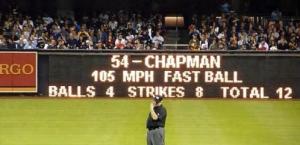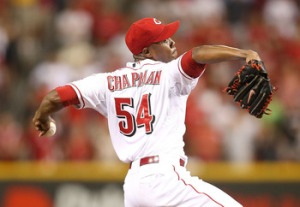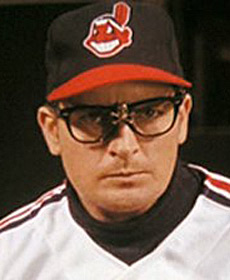The Fastball
By: Ryan
No 9th inning pitcher was feared more last year than Aroldis Chapman. The dude is a beast; standing 6’4 and throwing heat that tops 100 mph, he easily overpowers hitters and eliminates late game heroics. This kind of dominance led to extensive speculation in the offseason about a possible switch to the front half of games. If your best pitcher is your closer, why not have him start?
While this seems like an easy switch to make for a pitcher, there aren’t that many pitchers who have successfully made the switch. Sure there are numerous guys who have done it, but only John Smoltz and Dennis Eckersley remain the only two pitchers to record a 20 W season and a 50 Save season in their careers. The lack of other dominant names suggest the difficulties that pitchers face when transitioning, all of which should be considered when thinking about where Aroldis will pitch.
Obviously, the biggest difference between the two pitching roles is the number of innings. This impacts pitchers in two ways. First is the additional innings during the game, which is analogous to the difference between a sprinter and marathon runner. The marathon runner has to worry about their pace and making it to the end of the race, which is similar to the starter who needs to worry having enough juice to make it deep into the game. In comparison, the sprinter just needs to hurry up and finish. If Aroldis where to start games, his 100+ fastball would likely need be reduced to the mid 90’s so that he could log innings. A mid 90’s fastball is still great, but it lacks the dominance that helps Chapman as a closer. Without trying to overpower hitters on speed alone, Aroldis would have to develop great control over his pitches (which he isn’t known for).
The additional innings also brings Aroldis’ durability into question. His workload will increase from 75 innings a year to 180+. This is a huge increase, especially for someone who experienced left should fatigue after pitching 70 innings last year. The Reds could attempt to mediate this by implementing an innings cap similar to Strasburg after Tommy John, but that also presents problems that question the motive to move Chapman to SP.
An innings cap wouldn’t be the only thing Chapman would share with Stras, both are known for the infamous inverted W pitching motion. This is know to cause tremendous strain on the pitcher’s elbow and shoulder, sometimes resulting in Tommy John surgery as was the case with Strasburg. The inverted W could also explain Chapman’s fatigue at the end of last year, and exposes the risks that can come with a heavier workload.
If Chapman were to start, he’d also have to work through the lineup numerous times in a game. One of the key advantages pitchers use to do so is employ different pitches to deceive the hitter. Currently, Chapman has a fastball, a fastball, and a fastball. Ken Rosenthal of FoxSports.com saw Chapman start recently in spring training and noted, “He couldn’t get his off-speed stuff over the plate.” This is a major problem for any pitcher no matter how fast you throw. Without at least two more pitches at major league level, Chapman shouldn’t even be considered for the starting role.
It won’t help the Reds get to the playoffs by having Chapman struggle and become another mid rotation starter with an injury risk. Instead the Reds are making the right choice by leaving Chapman as the closer and the head a dominant bullpen.

How can we forget.
The Changeup
By: Matt
Aroldis Chapman wants to be a closer. The Reds are shooting for a World Series crown this year and Chapman was one of the best closers in baseball last year. If it ain’t broke, don’t fix it, right? Well…not exactly. Quite simply, if the Cincinnati Reds want to get the maximum value out of Aroldis Chapman. They need him to be a starting pitcher.
When the Reds originally signed Chapman to a six-year, $30.25 million contract in 2010, it was with the intention of making him into a starter. He was only thrust into the closer role last year because of injuries. And he took to it. He became one of the elite closers in baseball and his triple-digit fastball put fear into the hearts of many hitters. The back end of the Cincinnati bullpen was quite formidable, especially after a midseason trade for Jonathan Broxton. And the Reds roared into the playoffs with one of the best records in baseball before they ran into trouble. The ace of the staff Cueto went down with an injury, and the rest of the Cincinnati starters were not able to match up, leaving games out of reach and Chapman sitting in the bullpen watching. He logged only 3 innings of work, and gave up 1 run. Not quite the domination that fans were used to during the regular season. Mostly, since he didn’t get the chance to showcase his stuff in limited innings due to his role.
The role of the closer is sexy. They have been immortalized by Hoffman, Rivera, Wild Thing, and Beard, but their value is way overstated.
Short Term Value
While WAR has its downsides as a statistic, it is a decent metric for assessing value and will work for this case. Chapman posted a 3.6 WAR last year as the Cincinnati closer which ranked him among the top relievers, however, the difference between WAR for an average and an elite closer is about 1.0. For comparison, Chapman’s possible replacement Jonathan Broxton had a 1.1 WAR in 35 innings with Kansas City before his trade, so if you were to project his numbers across the 70+ innings that Chapman pitched in the regular season you would put him at about 2.2, close to the league average. So, we can project Chapman as about a +1 win player by keeping him in the closer role. An elite closer definitely helps their team, but as you can see, their value is limited.
Now let’s compare with starting pitchers. The league average starter that pitches a full season posts a WAR of around 2.3. The Reds fifth starter, Mike Leake would be the most likely to lose his job were Chapman to move to the rotation. Last year, he made 30 starts, threw 179 innings. Posted a 4.58 ERA and a 4.47 FIP, meaning these numbers were pretty close to accurate. All of this amounted to a WAR of 0.6. Even if Chapman were to not reach ace status and post only his baseline ZiPS projection, he would post a 3.63 ERA across 144 innings with a WAR of around 3.0. This would be far better than Leake, and create more net value and wins for the Reds in the short term than keeping him in the bullpen.
Long Term Value
As for the long term, the value would be way better. The track record for changing relievers into starters is there. Daniel Bard, Neftali Feliz, Lance Lynn, Jeff Samardzija, and Chris Sale have all had success recently. The most obvious comparison for our purposes is with Sale. The hard-throwing lefty made the transition from bullpen to starter last year to great results. The Sox were careful about spacing out his starts and giving him enough rest and he posted a 3.05 ERA in 192 innings with 192 Ks and 5.7 Wins Above Replacement. Sale made the jump to ace status immediately, and since both are hard-throwing left handers with movement, it seems possible that Chapman could do the same. The stuff is obviously there, as Chapman can pop 100 with ease. His slider is nasty, and reports show that his changeup, though still developing was starting to come along in Spring Training. If he were to start, comparisons to Randy Johnson or Dontrelle Willis’s early years are easy to make. If Chapman came even close to these levels, the Reds would be foolish to keep him trapped in the bullpen.
The Reds have a team that is built around a strong core of young players. Joey Votto, Jay Bruce, Todd Frazier, Johnny Cueto, Mat Latos, and Brandon Phillips are all under contract for multiple years, and all except for Phillips are under 30. The team does not have to mortgage their future to win right now, and by moving Chapman to a starting role, they would create more value in the short and long term.





